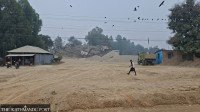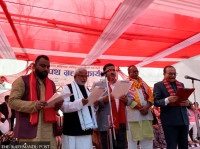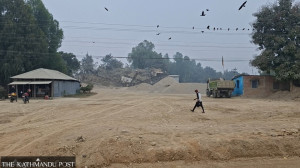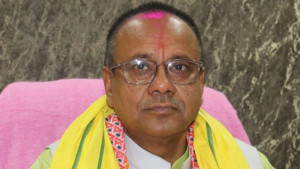Madhesh Province
Killing of a Madhesi brings age-old question to the fore: when can the police fire a live bullet?
The country’s law enforcement agency fails to exercise restraint during protests in Madhes, rights activists say.
Tika R Pradhan & Om Prakash Thakur
On Sunday afternoon, when residents of Ishwarpur in Sarlahi decided to gather on the East-West Highway to protest the death of a minor, Saroj Mahato was at the small restaurant he had started just last year.
A day earlier, a 12-year-old boy had died after falling into a 30-foot sand pit in the Banke river, and villagers were furious. The pit had formed due to illegal sand mining, according to local residents, under the protection of their elected representatives and the police.
By the time Mahato joined the protest, hundreds of people had gathered along the highway, demanding a halt to the illegal excavation of sand and stones from the river and compensation for the boy’s family.
But things quickly turned tragic. As the demonstration got larger, police fired live rounds at the protesters. Mahato, who was known to villagers as Kebal, was struck by a bullet on his head and died on the spot.
Mahato’s killing on Sunday, once again, has brought to the fore how the country’s law enforcement agency fails to exercise restraint, human rights activists say, and quickly resorts to firing live rounds when it comes to protests in the country’s southern plains.
“We are shocked by the gross human rights violations in this case,” Gyanendra Yadav, Province 2’s minister for internal affairs and law, told the Post over the phone on Monday.
Following the killing, an all-party meeting called by the District Coordination Committee on Monday demanded a judicial investigation into the incident and compensation for Mahato’s family.
“The family and villagers have said they will not receive the body until their demands are met,” said Pramod Shah, a provincial assembly member of Province 2. “The Chief District Officer has assured us that he will take initiatives to address our demands."
Activists have drawn attention to repeated instances in the past when the Nepal Police resorted to excessive force and indiscriminate firing when it came to protests in the Tarai.
In 2015, during the months-long demonstrations against the constitution, more than 40 people were killed in violent protests—15 protesters were shot dead by the police, according to Human Rights Watch.
Similarly, in the months leading up to the 2017 parliamentary elections, police had opened fire on protesters during an election-related fracas involving the then Samyukta Loktantrik Madhesi Morcha and the then CPN-UML. Five people were killed.
“Incidents of excessive use of force have been increasing in the Tarai,” said Charan Prasai, a human rights activist. “In many similar incidents in the past, victims were shot in the head. This shows that either the government has deployed untrained police personnel or the killing was intentional.”
Numerous reports by both national and international human rights organisations have detailed how the Nepal Police handles protests and treats citizens differently, depending on their ethnicities.
A recent report by Advocacy Forum, a human rights organisation, stated that communities from the Tarai, primarily Madhesis and Tharus, face higher rates of torture and violence while in police custody.
Deputy Inspector General of Police Pradhyumna Karki, chief of police in Province 2, however, defended the police action on the grounds that the situation had “gone out of control”.
After firing 15 rounds of tear gas shells, police also fired rubber bullets before firing into the air, said Karki. Protesters also hurled stones at security personnel.
“Security personnel were compelled to use force as they were left with no option. Several police personnel had been injured,” Karki told the Post.
But rights activists say the police did not follow due process.
“The authorities must prove that the situation was out of control,” said Gauri Pradhan, a human rights activist. “If such incidents continue, dissatisfaction among the public will only continue to increase.”
For activists, there are concerns over who authorised the police to open fire. Under Nepali law, the riot police are not authorised to independently fire live rounds on protestors.
According to Karki, such decisions are taken by the District Security Committee, which is led by the chief district officer; a lieutenant colonel from the Nepal Army; superintendents from the Nepali Police, Armed Police Force and National Investigation Department; and an assistant chief district officer as the member secretary.
Sarlahi Chief District Officer Krishna Bahadur Raut, however, said that a field officer “had consulted with his supervisor”, who had given permission to fire on the crowd. Raut said that this too is correct due process, especially if officers believe that their lives are in danger.
For provincial government officials, decision-making over sensitive matters relating to security has long been a bone of contention, as they don’t have any representation on the security committee.
Federal and provincial governments have long been at odds over a proposed Police Bill, which provisions for chief district officers to “coordinate” security matters. Provincial governments have taken issue with this provision, as chief district officers are appointed by the federal government and are accountable to the Home Ministry in Kathmandu, not to the provincial internal affairs ministry. So provincial governments have no power of their own to mobilise police or to hold them to account.
Even as the police continued to justify their actions throughout Monday, Mahato’s family, including his wife and six-month-old son, was in mourning. Mahato had just returned from Qatar over a year ago and started his restaurant with his brother Manoj.
“Just before he was shot, Saroj was saying we should return home because the police had started using force,” Manoj told the Post. “We went to protest the death of a village boy due to government negligence and in the process, I lost my brother.”




 8.12°C Kathmandu
8.12°C Kathmandu













